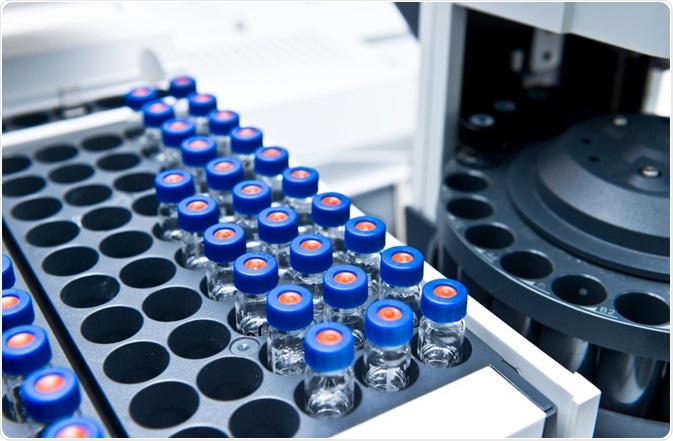Commonly used in food science, pharmaceuticals, and forensic toxicology, the instrument liquid chromatography-mass spectrometry (LC-MS) can identify most organic compounds ranging from proteins to pharmaceutical products in the market.
Compared to the analytical technique GC-MS, LC-MS has a wider usage to analyze chemical compounds that are thermally unstable, non-volatile, polar, ionic, and large. The improvements that transcend LC-MS to become the easy-to-use, selective and sensitive technique it is today have made the instrument more appealing in various applications.

LC-MS. Image Credit: unoL/Shutterstock.com
Liquid Chromatography
Liquid chromatography is a technique that separates a sample based on the differences in the size, adsorption, and partitioning affecting how different solutes interact between the mobile phase and the stationary phase. The mobile phase is the solvent, and the stationary phase is the column. The instrument contains an autosampler that allows the sample to be introduced and carried by the mobile phase through the HPLC column.
The eluted solute bands from the result of separations between the LC column and the mobile phase is then detected by a detector. This detector then sends the electrical signals to a computer so that the chromatogram can be generated to identify and quantify the amount of each chemical component in the mixture.
Mass Spectrometry
Liquid chromatography may also be coupled with mass spectrometry for further analysis of the chromatogram generated. Mass spectrometry is used to measure the molecular weight of the individual chemical components present within a mixture by measuring the mass-to-charge ratio (m/z) of the ions present. The results are obtained based on the ionization and fragmentation of the molecules existing in a sample.
These ion fragmentation patterns can then be utilized to acquire the structural information of that molecule. The process of mass spectrometry is followed by ionizing a sample to cations by the loss of an electron, separating these ions based on their mass-to-charge ratios, and measuring these fragmented ions.
The resulted spectrum is displayed as a vertical bar graph where the mass-to-charge is plotted against the relative intensity of each fragment ion. This spectrum can then be compared to a suitable reference database to identify the separated compounds.
Applications of LC-MS
LC-MS is a common technique in forensic laboratories to identify various illicit drugs in biological as well as chemical matrices, dyes in fibers as trace evidence, and fire debris from a particular crime scene.
More commonly, approximately 70% of the samples brought to forensic toxicology laboratories are handled by liquid chromatography for its efficiency in detecting polar and thermally labile chemical compounds. The instrument's ability to analyze semi-volatile samples, its rapidness, and the lack of derivatization needed, has made LC-MS the more favorable technique compared to GC-MS.
Applications of the instrument within the pharmaceutical industry involves the analysis of suspected drug substances occurring in natural and synthetic sources, as well as drug metabolism in the body. The instrument has allowed drug manufacturers to develop, compare, and control the quality of drug products through its chromatography element. Its mass spectrometry element serves to improve the limits of detection for pharmaceutical analysis of complex drug mixtures, as well as their molecular structures.
The use of LC-MS has also been growing rapidly in drug development over many years. Its improvements in its features to quantify drugs, as well as qualitative and structural analysis of drugs, has provided the pharmaceutical industry with more advancements. It further provides a rapid turn-around of samples without compromising the quality of the analysis to generate accurate information, which is a primary advantage for the fast-growing pharmaceutical industry.
In environmental sciences, LC-MS is useful for the identification and quantification of compounds in drinking water, wastewater, and soil. For instance, the class of pesticides carbamates can be detected by the APCI-LC/MS without derivatization, compared to the common method of post-column derivatization and fluorescence detection.
Through APCI-LC/MS, the individual chemical components in a matrix can be detected through the corresponding peaks on an extracted ion chromatogram without derivatization.
Limitations of LC-MS
Although known for its key features in providing rapid analysis of complex mixtures and quality performance, LC-MS is an expensive instrument that might deter laboratories that are on a tight budget. Furthermore, the operation of the instrument requires an approximate training of 3 to 6 months for a scientist to be comfortable performing new LC-MS assays. The instrument maintenance, troubleshooting as well as implementing new tests should be taken into account when employing LC-MS.
Another limitation of LC-MS is its sample throughput, especially in smaller clinical laboratories. Samples often encountered in high volumes such as testosterone, cortisol, 25OHD2 as well as 25OHD3 are tested every day in the laboratories.
Because of the need for timeliness of these test results, automated immunoassays are often the preferred method compared to the quality of results generated from LC-MS. The waste disposal of hazardous solvents from the LC-MS workflows is also an additional problem for laboratories dealing with thousands of chemical tests every day.
References
- Basics of LC/MS, Agilent, Palo Alto, CA, USA, 1998. Accessed on: Dec. 12, 2020. [Online]. Available: https://www.agilent.com/cs/library/support/documents/a05296.pdf
- Grebe, S.K., and Singh, R.J.,2011. LC-MS/MS in the clinical laboratory–where to from here?. The Clinical Biochemist Reviews, 32(1), p.5. https://www.ncbi.nlm.nih.gov/pmc/articles/pmc3052391/
- Pang, B., Zhu, Y., Lu, L., Gu, F., and Chen, H., 2016. The applications and features of liquid chromatography-mass spectrometry in the analysis of traditional Chinese medicine. Evidence-Based Complementary and Alternative Medicine, 2016. https://www.hindawi.com/journals/ecam/2016/3837270/abs/
- Van Bocxlaer, J.F., Clauwaert, K.M., Lambert, W.E., Deforce, D.L., Van den Eeckhout, E.G., and De Leenheer, A.P., 2000. Liquid chromatography-mass spectrometry in forensic toxicology. Mass spectrometry reviews, 19(4), pp.165-214.
- https://doi.org/10.1002/1098-2787(200007)19:4%3C165::AID-MAS1%3E3.0.CO;2-Y
- Waters.com. 2020. How Does High-Performance Liquid Chromatography Work? : Waters. [online] Available at: <https://www.waters.com/waters/en_US/How-Does-High-Performance-Liquid-Chromatography-Work%3F/nav.htm?cid=10049055&locale=en_US> [Accessed 14 December 2020].
Further Reading
Last Updated: Oct 12, 2021